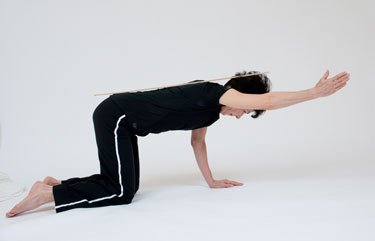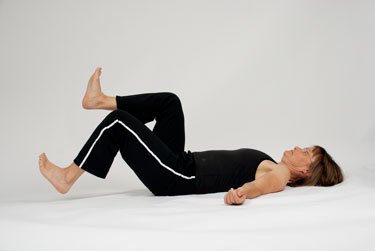Table of Contents
Today I am going to talk about hypermobility exercises and specifically what modifications you need to make to have a hypermobility syndrome exercise program that is safe and effective. I have a section dedicated to core exercises for hypermobility. Finally, I answer the question: Do people who have hypermobility syndrome need to be careful with their choice of exercise and should they modify their exercise routine?
Hypermobility Exercises
Hi. I’m Margaret at MelioGuide, and today I’m covering part three of the hypermobility spectrum disorder, hypermobility exercises.
We will look at elements of exercise as it relates to people who are more mobile than the average individual — people who have hypermobility syndrome.
We will discuss specific challenges and modifications you should make to your exercise routine.
I suggest you go back my first blog on this, so that if you’re wanting a clearer definition of what hypermobility syndrome is all about.
(In the first two parts of this series, I covered hypermobility test and yoga and hypermobility. To determine if you have hypermobility syndrome, I encourage you to complete the hypermobility test.)

Core Exercises for Hypermobility
The following are recommended core exercises for hypermobility.
- Plank exercise.
- Side plank exercise.
- Basic abdominal activation exercise.
- Abdominal activation with a leg drop.
- Abdominal activation with a 90/90 leg drop.
- Advanced abdominal activation with leg drops.
- Horse stance in vertical position.
- Horse stance in vertical position.
Core exercises for hypermobility will help you offset the postural, flexibility and balance issues associated with hypermobility syndrome. I recommend certain clients practice several core exercises for hypermobility.
Each of the core exercises for hypermobility listed above is described in detail in Strengthen Your Core and Exercise for Better Bones.
Here are a few points to consider regarding core exercises for hypermobility.

Benefits of Core Exercises for Hypermobility
Core exercises, when done properly, benefit the back and abdominal muscles, which in turn protect your spine. Core exercises for hypermobility help you establish and maintain a neutral position so that your movements and exercises are executed without causing hypermobility of the joints.
Components of Core Exercises for Hypermobility
Core strength goes beyond the abdominal muscles. It incorporates the diaphragm, pelvic floor, and the muscles of the spine, the hips, and the shoulders. Core exercises for hypermobility are designed to address address all of these areas while delivering the benefits. Here are the key components of program of core exercises for hypermobility:
- Establish a neutral spine position to eliminate or reduce flexion and extension of the spine.
- Integrate the pelvic floor. The pelvic floor is the foundation of core stability.
- Use core breathing from the diaphragm to support your core.

Exercise Challenges for People with Hypermobility Syndrome
Individuals who have hypermobility syndrome have several challenges when it comes to exercise.
Hypermobility and Posture
The first challenge to hypermobility exercises is maintaining perfect posture. Perfect posture is much easier to obtain if you have normal mobility. Because if somebody with normal mobility goes out of range, we can start feeling it, we can feel the tightness in the joints and our ligaments are starting to yell at us a little bit.
I have hypermobile knees and used to just be able to stand with my knees way back (hypermobile knees that went too far back). I could hold this position for a long period and compensate by keeping my hips in a forward position. My lower body never told me (or “cued” me) that I was hypermobile.
However if you’re hypermobile in many parts of your body, you never get that cueing about what your neutral body position needs to be.
Exercise form requires starting in a neutral position. If you are not getting cues that you are hypermobile, then you never get into that starting neutral position. For many people, getting into a neutral position and transitioning into exercise is a huge step.
It’s critical for somebody that has hypermobility syndrome to have a teacher that:
- Teaches them well
- Looks at how they are moving and makes sure that they are moving within a safe range of motion.
- Makes corrections as they are needed.
Hypermobility and Alexander Technique
At the hypermobility.org website they talk about the “Alexander Technique“. Check it out.
Physical Therapy for hypermobility syndrome is also important. However, make sure that the practitioner is trained in movements and teaches you proper hypermobility exercise and movements.
Because a lot of people with hypermobility have pain, passive modalities in treatment might not be as effective as learning proper hypermobility exercise and movements. To get out of the pain spectrum you need to learn to move well.
Hypermobility and Flexibility (Stretching)
The second challenge for individuals with hypermobility syndrome are their flexibility exercises — often seen in yoga. If you practice hypermobility exercises, you might need to adjust your stretching routine.
As I mentioned in the blog on yoga and hypermobility you need to learn how to stretch the muscles that are tight and not over stretching the joints that are already loose. That’s very critical if you have hypermobility syndrome.
Hypermobility and Balance
The third challenge to hypermobility exercises is balance.
Because your joints are so much more mobile, you’re not getting proper feedback on your balance.
Your little joint receptors that give your brain that information, the proprioceptors, aren’t firing as quickly as those for of individuals who have less mobile joints.
Safe and effective balance exercises and gradual progression of balance exercise is very very critical for individuals that have hypermobility syndrome.
Hypermobility and Osteoporosis
Many of my clients are diagnosed with osteoporosis or osteopenia and a large majority of them also happen to be hypermobile. They often score anywhere between one and nine on the Beighton Hypermobility Scale.
A study (1) going back to 2006 looked at 25 premenopausal women that were prediagnosed, using the BeightonHypermobility Scale, as being benign hypermobile or having the Benign Hypermobility Syndrome.
The researchers matched this group with 25 age-matched controls. All of the women in the control group were Caucasian. Further, they matched in terms of:
- Body mass index.
- Number of pregnancies they had had.
- If they had nursed.
- How many years they had nursed or lactated for.
- Their calcium intake.
- Physical activity level.
This is a very good control study in the terms of matching all of the characteristics that we know affect our bones.
The researchers looked to answer the following questions:
- Was there a difference in their bone mineral density at the hip — specifically the trochanteric bone mineral density?
- Was there a risk for lower bone mass?
The research team found that the women diagnosed with Benign Hypermobility Syndrome showed a decrease in the bone mineral density at the trochanteric site located at the hip and demonstrated an increased risk for low bone mass, by as much as 1.8 times, compared to the control group.
What does this mean?
If you are hypermobile and you are premenopausal, I strongly encourage you to have a bone mineral density test well before the recommended age of 65.
Conclusion
If you have hypermobility syndrome, your approach to exercise and movements needs to be different than most people. You should have a better idea of adjustments you need to make to your exercise regime. Your persistence in safe movement (during exercise and your activities of daily living) will lead to you having a healthier and stronger body.
References
- Gulbahar S, et al., Hypermobility syndrome increases the risk for low bone mass. Clin Rheumatol, 2006 Jul:25(4):511-4
Joint Health
Visit my page dedicated to Joint Health.

Comments